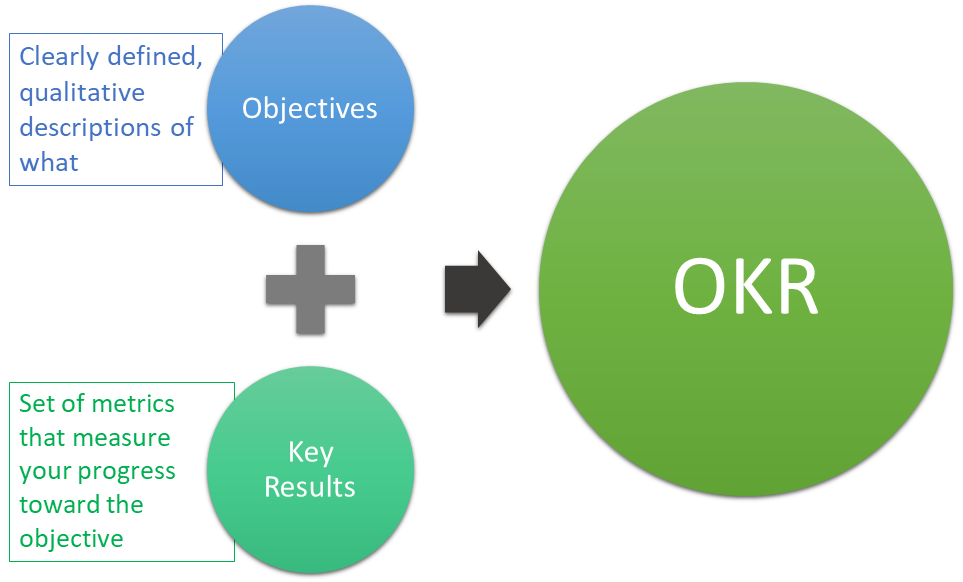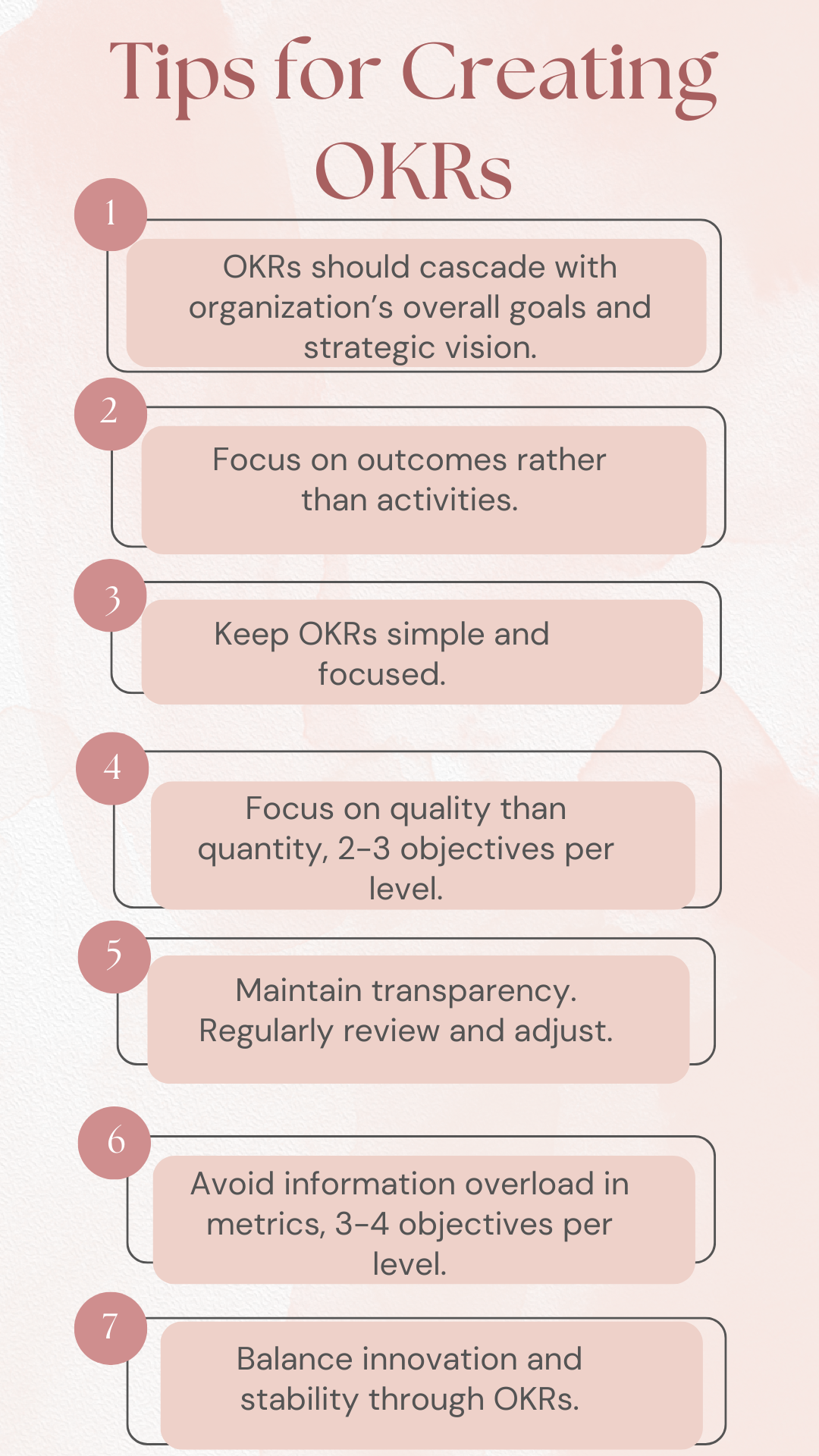How to Setup OKRs Properly
|
|
OKRs, which stands for “Objectives and Key Results,” is a goal-setting framework that has existed since the ’70s. Andy Grove introduced it, and has since been used by organizations, teams, and individuals to define measurable goals and track their outcomes.
Analogy to better understand an OKR
Imagine your family has decided to go on a road trip this summer. The objective is to “Have a memorable and fun family road trip.” This objective is aspirational, broad, and qualitative. It sets a clear, inspiring goal that everyone in the family can get excited about and contribute towards achieving.
To make this road trip successful and ensure the objective is met, you need specific, measurable outcomes, which are your key results. These could be:
- Visit at least three national parks along the route: This is measurable as you can count the parks you visit. It also directly contributes to the fun and memorable aspects of the trip.
- Stay within the budget of $2000 for the entire trip: This key result is quantifiable and ensures financial accountability, impacting the trip’s feasibility and sustainability.
- Create a travel log with photos and notes from each location visited: This result measures the trip’s memorability and ensures that memories are captured in a tangible form.
Takeaways from OKRs
The above road trip analogy helps us better understand what OKRs do for us. Let’s examine it.
- Planning and preparation: Before you hit the road, you plan the route, book accommodations, and decide on activities. This phase is akin to setting up your OKRs at the start of a business quarter or year, where you define success and how you will measure it.
- Checking progress: Just as you might check your map regularly, take stock of expenses, and collect souvenirs in a business setting, you periodically review your key results to see if you are on track to achieve your objectives.
- Adjustments along the way: Sometimes, road closures or interesting detours might require you to adjust your plans. Similarly, if certain key results are off-track, you might need to realign resources or shift focus mid-quarter.
- Sharing the journey or documenting: Throughout the trip, you share progress and stories with each other, enhancing the experience. In an organization, sharing OKR progress promotes transparency, boosts morale, and fosters a sense of shared purpose.
Benefits of using OKRs
If you’ve decided to implement OKRs in your organization, then you will not be disappointed. This goal-setting framework works wonders for getting the job done. Here are the benefits of using OKRs.
- Alignment and focus: OKRs provide a clear framework for setting ambitious yet achievable goals (Objectives) and tracking progress through measurable results (Key Results). This ensures everyone in the organization, from leadership to individual contributors, understands the overarching objectives and how their work contributes to them. This fosters a unified direction and eliminates confusion about priorities.
- Transparency and Communication: The OKR setting process typically involves collaborative discussions between teams and stakeholders. This transparency in goals and expectations leads to better communication and collaboration across departments. Everyone is aware of the bigger picture and can tailor their efforts to support achieving the shared objectives.
- Improved motivation and engagement: By setting clear objectives with measurable key results, OKRs make success tangible and motivate teams to strive for ambitious yet achievable goals. Seeing the connection between their work and the organization’s success can lead to increased engagement and ownership among employees.
- Data-driven decision-making: Regular OKR reviews allow teams to track progress toward key results. This data-driven approach helps identify roadblocks, measure the effectiveness of strategies, and make informed decisions about adjustments or resource allocation.
- Flexibility and agility: OKRs are designed to be adaptable. Objectives can be adjusted as circumstances or priorities change, and key results can be modified to reflect new information. This flexibility allows organizations to remain agile and responsive to market changes or unforeseen challenges.
- Stretch goals and innovation: OKRs often encourage setting ambitious (but achievable) goals. This can push teams to think creatively and develop innovative solutions to achieve the desired outcomes.
What do OKRs comprise of?
OKRs comprise of two main components:
Objectives
The aim of an objective is to articulate what one aspires to accomplish, pushing the boundaries of what seems possible. Here are the attributes that make for a good objective.
- Aspirational but achievable: Objectives should be ambitious enough to inspire and challenge but realistic enough that they can actually be achieved with concerted effort.
- Clear and concise: Objectives need to be stated clearly and simply to ensure everyone understands and remembers them.
- Qualitative: Objectives should describe desired outcomes in qualitative terms, focusing on the “what” rather than the “how.”
- Aligned with the vision: They should be directly aligned with the organization’s overall mission and vision, supporting larger strategic goals.
- Motivating: The objectives should be formulated in a way that motivate and engage the team members who will be working toward them.
Key Results
These are measurable outcomes that track the progress toward the objective. Good Key Results tend to be:
- Quantifiable metrics: Key results must be measurable. They should define success in numerical or quantitative terms.
- Objective and verifiable: It should be straightforward to determine whether a key result has been achieved. Avoid ambiguity in measurement.
- Directly linked to objectives: Each key result should directly contribute to achieving its objective. They should act as benchmarks that define progress towards the overarching goal.
- Time-bound: There should be a clear timeframe within which the key results will be achieved, typically by the end of the OKR cycle.
- Challenging yet realistic: Key results should stretch the team’s capabilities but remain within the realm of possibility.

How to write OKRs?
With the following guide, you can develop efficient yet impactful OKRs.
Define the Context
- Goal Setting Level: Identify the level for which you’re setting OKRs (company, department, team, or individual). Understanding the level helps tailor objectives to the appropriate scope.
- Company Vision and Strategy: Ensure your OKRs align with the organization’s overall vision and strategic goals. This ensures all objectives contribute to the bigger picture.
Craft Compelling Objectives
- Start with Brainstorming: Hold brainstorming sessions involving relevant stakeholders to discuss priorities and desired outcomes.
- Focus on Quality, not Quantity: Aim for 2-3 ambitious yet achievable objectives that capture the essence of what you want to accomplish.
- Write Clear and Concise Objectives: Objectives should be qualitative statements that are easy to understand and inspire teams.
Develop Measurable Key Results
- Align with Objectives: For each objective, brainstorm key results that clearly define success. Ensure they directly contribute to achieving the objective.
- Focus on Measurable Outcomes: Key Results should be quantifiable metrics with a clear definition of how progress is measured (e.g., percentages, numbers, ratings).
- 2-5 Key Results per Objective: Maintain a focused approach by having a limited number of key results for each objective.
- Set Stretch yet Achievable Targets: While ambitious, key results should be achievable with focused effort and the right resources.
- Time-bound: Define a timeframe (e.g., quarter, year) for achieving each key result, fostering a sense of urgency and clear deadlines.
Refine and Get Feedback
- Seek Feedback and Iterate: Share your draft OKRs with relevant stakeholders and solicit feedback. This ensures alignment and incorporates valuable perspectives.
- Refine Based on Feedback: Incorporate valuable feedback to refine your OKRs and ensure clarity, ambition, and measurability.
Tips to write good OKRs

Conclusion
As a leader, you must set a good example for your teams by giving them clear goals and targets to achieve. By following these best practices, you can create OKRs that are clear, ambitious, measurable, and aligned with your organization’s goals.
Additional Resources
- Director of Engineering Cheat Sheet
- Top-25 VP of Engineering Interview Questions
- What Exactly Do QA Directors Do? Job Description & Responsibilities Overview
- Earning the Title: The Road to Chief Technology Officer and the Salary Reward
- The Modern CTO: Is There a Necessity of Technical Expertise?
- More Efficient Way to Do QA
- Continuous Integration and Testing: Best Practices
- Test Automation Tool For Manual Testers
Frequently Asked Questions (FAQs)
You need to start by setting company-level OKRs that reflect the overall strategic goals and then work with department heads to develop departmental OKRs that support these larger objectives. Regular alignment meetings and OKR reviews can ensure that departmental goals remain aligned with company objectives.
Senior leaders play a crucial role in modeling commitment to the OKR process, providing guidance, and ensuring resources are available to achieve key results. They should actively participate in setting and reviewing OKRs, offering support, and removing obstacles for their teams.
Do this by maintaining transparency by sharing OKRs openly and celebrating achievements. Also, team members should be involved in the OKR setting to enhance buy-in and accountability. Regular check-ins and feedback sessions can keep everyone engaged and informed about progress and challenges.
You need to avoid setting too many OKRs, which can dilute focus, and ensure that critical results are measurable and genuinely indicative of success. Also, beware of setting goals that are too easy or challenging, and avoid linking OKRs directly to performance evaluations or compensation, as this can inhibit ambitious goal setting.
It’s essential to be flexible and adaptive. If significant changes in strategy or market conditions occur, OKRs should be reviewed and adjusted as necessary. This flexibility helps keep the organization agile and responsive to external factors.
| Achieve More Than 90% Test Automation | |
| Step by Step Walkthroughs and Help | |
| 14 Day Free Trial, Cancel Anytime |












